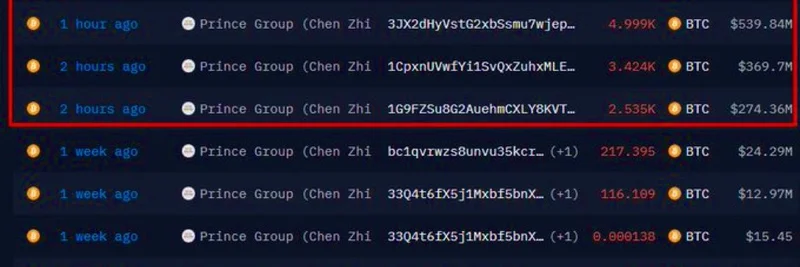If you've been following the wild world of crypto, you know that big money movements can signal everything from market shifts to unresolved mysteries from the past. Recently, a tweet from @MrWhaleREAL caught the community's eye, highlighting a massive transfer of Bitcoin from a wallet connected to an old hack. Let's break it down step by step, keeping things straightforward for anyone dipping their toes into blockchain news.
The Tweet That Started It All
The post reads: "🚨 BREAKING: A hacker wallet linked to the Lubian mining pool hack has moved 15,959 $BTC (~$1.83 B) to four new addresses, according to OnchainLens." This isn't just any transfer—it's a reminder of how past exploits continue to ripple through the crypto ecosystem years later.
As you can see in the screenshot shared in the tweet, the transfers originate from an address labeled "Prince Group (Chen Zhi)." These moves happened in quick succession, with amounts like 4.999k BTC (worth over $539M at current prices) heading to new wallets. For context, Bitcoin's price has been hovering around $115,000 per coin in late 2025, making these sums eye-wateringly huge.
Background on the Lubian Mining Pool Hack
To understand why this matters, we need to rewind to December 2020. Lubian, a Bitcoin mining pool with operations in China and Iran, suffered a massive breach. Hackers made off with around 127,426 BTC, valued at about $3.5 billion back then. According to reports from blockchain analytics firm Arkham Intelligence, the theft went largely unnoticed at the time because the pool managed to salvage some funds, but the bulk remained in dormant wallets.
Fast-forward to 2025, and these wallets have started waking up. Just last week, the U.S. Department of Justice announced the seizure of over $15 billion in Bitcoin—now inflated by BTC's price surge—linked to cybercrime networks. Many in the crypto space speculate this haul ties directly to the Lubian hack, especially given the connections to Cambodian tycoon Chen Zhi and his Prince Group.
Who Is Chen Zhi and the Prince Group?
Chen Zhi, a Chinese-born businessman with Cambodian and British citizenship, heads the Prince Holding Group, a conglomerate involved in real estate, finance, and more. But recent U.S. indictments paint a darker picture: allegations of running forced labor compounds in Cambodia for "pig butchering" scams. These are sophisticated frauds where scammers build fake relationships online to lure victims into investing in bogus crypto schemes, often involving meme coins or pump-and-dump tokens.
The U.S. Treasury Department has sanctioned 146 entities tied to the Prince Group, labeling it a transnational criminal organization. The seized Bitcoin? It's believed to stem from these illicit activities, including potential links to the Lubian hack proceeds. While the exact connection isn't fully confirmed, on-chain data from tools like OnchainLens points to overlapping wallet activities.
What Does This Mean for Meme Tokens and Crypto Investors?
In the meme token space, where quick gains and viral hype rule, stories like this underscore the risks lurking beneath the surface. Pig butchering scams often promote fake or rug-pull meme coins, preying on FOMO (fear of missing out) to drain wallets. With billions in stolen BTC potentially funding such operations, it's a wake-up call for better due diligence.
Blockchain analytics platforms, like the one mentioned in the tweet (OnchainLens), play a crucial role here. They track wallet movements in real-time, helping spot suspicious activity before it escalates. For meme coin enthusiasts, this means always verifying project legitimacy—check for audited smart contracts, transparent teams, and community vetted by tools like DexScreener or CoinMarketCap.
Why Track These Movements?
Large transfers from historical hack wallets can influence market sentiment. Traders watch for potential dumps that could pressure BTC prices, while regulators use them to trace criminal networks. In this case, the four new addresses receiving the funds might be part of consolidation or even government handling post-seizure. As of now, no major sell-offs have hit exchanges, but the crypto community is on high alert.
If you're building your knowledge base on meme tokens and blockchain tech, events like this highlight the importance of security. Use hardware wallets, enable two-factor authentication, and stay informed through reliable sources. Meme Insider will keep you updated on how these big-picture stories intersect with the fast-paced world of meme coins.
Final Thoughts
This tweet isn't just news—it's a snapshot of crypto's ongoing evolution, where old hacks meet modern forensics. Whether you're a seasoned trader or new to the scene, understanding on-chain activity can give you an edge. Keep an eye on wallets like these, and remember: in crypto, transparency is your best friend.



